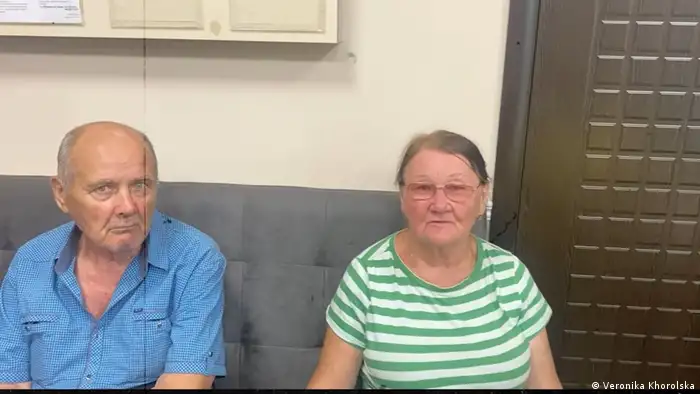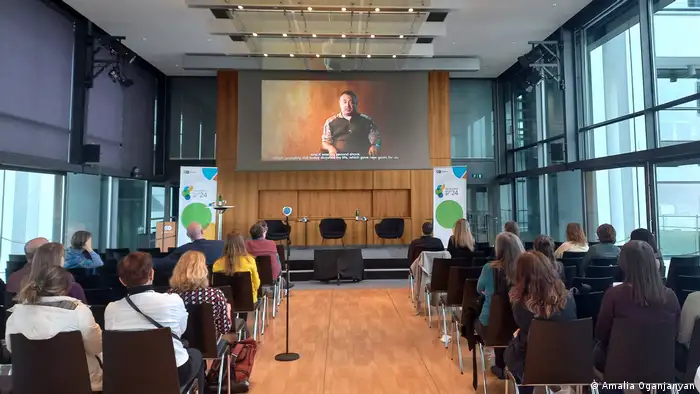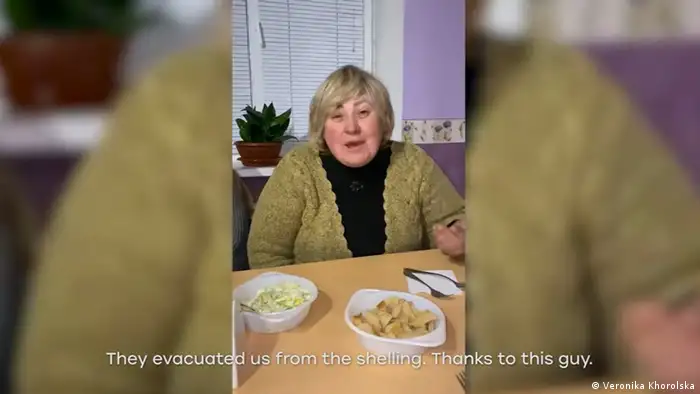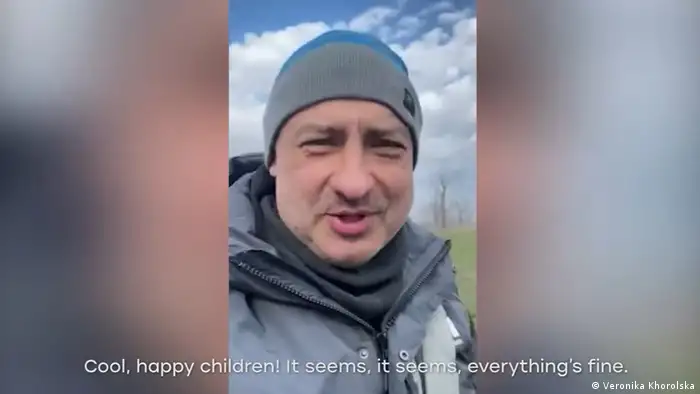Europe/Central Asia
A new documentary shows thousands saved in Mariupol
MediaFit filmmaking participant Veronika Khorolska tells the story of one man’s perilous efforts to rescue more than 8,000 civilians trapped in Mariupol, Ukraine.
An older couple sit drained of emotion as they quietly recount the bombs, their house burning to the ground, losing everything they own, including their passports. But still, they managed to escape escape from the occupation zone where they lived in Mariupol.
They were among some 8,000 people eventually bussed out of the embattled city in eastern Ukraine less than a month after the full-scale Russian invasion on February 24, 2022. Their futures were uncertain, but at least they survived the deadly violence.
What seemed an improbable and highly dangerous venture would turn into something of a miracle for these refugees – the shuttling of locals out of Mariupol to safety.

Mariupol residents who lost everything in their house destroyed by Russian bombing. They were among the first refugees bussed out of the city by fellow resident Askold Kvyatkovsky who organized dozens of evacuations.
Hope for All
"I used to have an event business before the war," Mariupol resident Askold Kvyatkovsky placidly explains into the camera as he ignores the sweat on his forehead. Cue to dreamy images of gala parties and him hosting fancy parties across two decades of relative peacetime.
But then, "life turned upside down," Kvyatkovsky explains in a new documentary. "Celebrations, joy, events, unexpected greetings and surprises changed to constant stress and the constant expectation that something bad was about to happen."
Kvyatkovsky's extraordinary journey from emcee to heroic rescue driver is the subject of the 43-minute documentary "Hope for All," made as part of DW Akademie’s MediaFit project. Funded by the EU and Germany's Federal Ministry for Economic Cooperation and Development (BMZ), the project's Creators Fund provides grants for Ukrainian media professionals to develop high-quality and diverse media. Veronika Khorolska, the documentary's filmmaker, is among 60 recent MediaFit grantees who worked on podcasts, multimedia reportages, films, photodocumentaries and fact checking projects.

The documentary "Hope for All," made by Veronika Khorolska, spotlights Mariupol resident Askold Kvyatkovsky who organized buses in and out of the city to evacuate people trapped there. Some 8,000 residents were able to flee on the buses
A huge impact
Yet Khorolska explained that, as compelling as Kvyatkovsky’s story is, she vacillated on several topics before settling on him as a single interview subject.
"I talked with him for about four hours," she recalled during a panel discussion at a recent DW Akademie conference in Bonn. "I was a little unsure, because it would be essentially just one person. But the truth is that this one person had a huge impact on so many people, including many orphans in Mariupol."
A city under siege
In early March 2022, electricity and other utilities had been cut in the city. Shops were plundered and residents warmed themselves in the freezing cold by building campfires in the street. Yet Kvyatkovsky, in a self-made video, walks about with the cheerful news that it's a good day because, while a bomb had dropped nearby, it hadn't exploded.
His gallows humor soon gives way to dread and helplessness when a friend welcomes him into a bomb shelter where Kvyatkovsky sees some 300 people huddled together, covered in gray basement dust, holding plastic disposable plates, begging for food. The majority, he notices, are children.
After asking his friend for some fuel, he returns to his car that had just been shot up by snipers. With several children from the basement in tow, he begins what will become the first of many journeys out of Mariupol. He and his passengers were laughing, he remembers, but it was nervous laughter, on the verge of hysteria. They reached villages, which he says he doesn't want to name, where locals agree to take in the refugees.

A Mariupol resident who fled the city on one of the evacuation buses organized by Askold Kvatkovsky.
"Bless them," he says with a smile and chuckle. "They are true heroes."
But there is no rest for the weary. Kvyatkovsky soon hires a bus – and shortly later, two more – and the caravan is quickly back on the road, headed to Mariupol. A young boy with his grandmother, mothers with toddlers, widows, all terrified of leaving the bomb shelter – the documentary shows the various passengers piling inside the buses and waving from fogged-up windows. All in all, Kvyatkovsky will organize seven trips in and out of Mariupol.
"You learn everything on the run," Kvyatkovsky says. "No one teaches you evacuation, rescuing. You have to immediately learn everything."
Resilience
As conditions become even more dangerous with more frequent bombings, and as the authorities catch onto his rescue efforts, he steps back from travelling himself. He decides to recruit more volunteers, including a surgical nurse. He takes to Instagram to chronicle the bus rescues. Followers in the United States and New Zealand offer to help in any way they can. Many assist with relaying messages when communication around Mariupol becomes impossible. Kvyatkovsky then uses this information to organize more buses.
Later, he hears from a 12-year-old girl and her father who had lost their mother and other relatives before leaving Mariupol with one of the rescue buses. The young girl had lost several fingers before evacuating, but she tells him that she and her father made it to Germany, and an operation had salvaged her hands. In a video, she plays the flute for him.
DW Akademie's project "MediaFit Programme for Information Integrity in southern and eastern Ukraine" (2021-2024) is funded by the EU and is also made possible with support from Germany's Federal Ministry for Economic Cooperation and Development (BMZ). The Creators Fund is a core element of MediaFit. The goal is to support innovative and relevant media content for regional audiences in Ukraine.
More about MediaFit
Related topics
Audios and videos on the topic
- Date 16.04.2024
- Feedback: Send us your feedback.
- Print Print this page
- Permalink https://p.dw.com/p/4eORF
- Date 16.04.2024
- Send us your feedback.
- Print Print this page
- Permalink https://p.dw.com/p/4eORF

